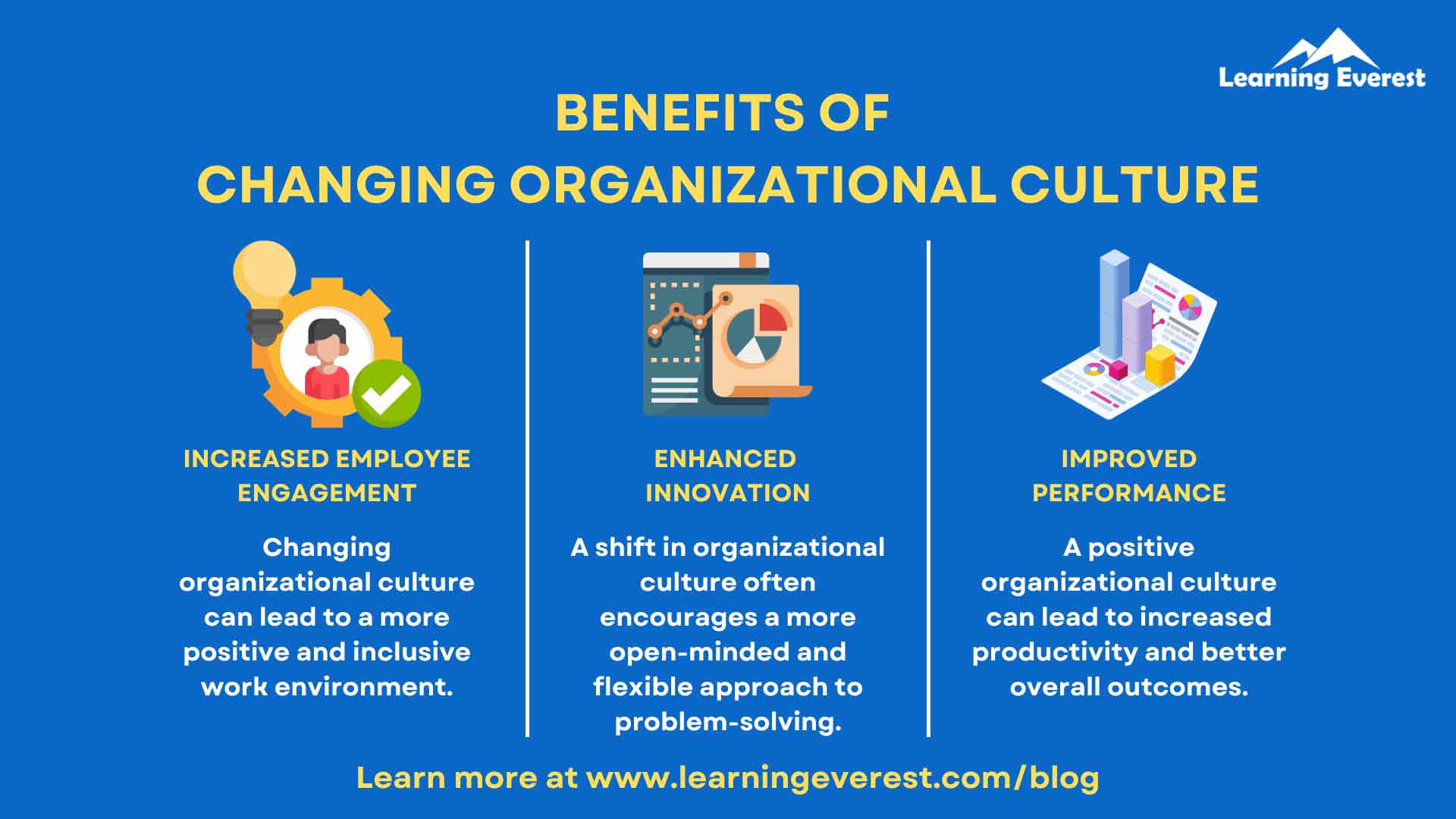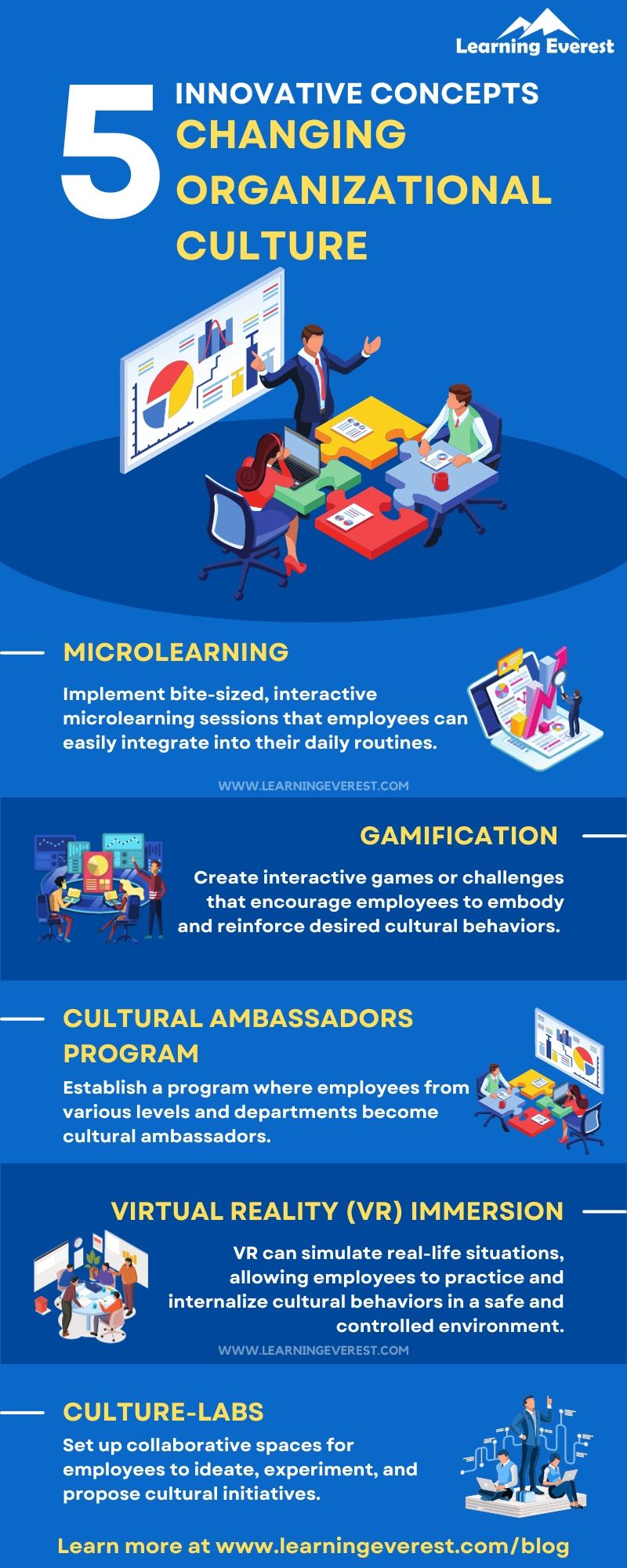Organizational culture is the collective personality of an organization. It’s the spoken and unspoken behaviors and mindsets that define how the business functions on a daily basis. Organizational culture primarily includes the mission and objectives along with values, leadership and employee expectations, structured performance management, and overall engagement levels. By creating a strong organizational culture, businesses can provide consistency and direction, guide decisions and actions, fuel the workforce, and help them reach their potential. As the business evolves, the need to adapt and change organizational culture, therefore, becomes increasingly important. In this blog, we will discuss the importance of changing organizational culture, the challenges it entails, and a comprehensive roadmap to navigate this transformative journey through eLearning.
Table of Contents
- The Significance of Organizational Culture
- Challenges in Changing Organizational Culture
- eLearning as a catalyst for changing organizational culture
- Infographic
- Knowledge Check!
- Frequently Asked Questions (FAQs)
- 1. What role does leadership play in changing organizational culture?
- 2. How can a positive organizational culture impact customer satisfaction and loyalty?
- 3. Can organizational culture be measured, and how is progress assessed?
- 4. Why is adaptability crucial for organizational culture in a rapidly changing business landscape?
The Significance of Organizational Culture
Here’s why organizational culture is so significant:

Benefits of Changing Organizational Culture
Let’s discuss in detail.
1. Employee satisfaction
High levels of job satisfaction are closely tied to a culture that supports professional growth, work-life balance, and a supportive community. A positive and inclusive work culture makes people feel like they belong and have a purpose. When employees feel appreciated and involved, they tend to work harder and stick to their jobs. A culture that gives power to all employees encourages them to take on leadership roles as well. This not only makes the pool of talented employees stronger but also builds a diverse and energetic leadership team.
2. Innovation and creativity
An environment where people freely communicate, take risks, and work together is good for coming up with new ideas. When employees feel comfortable sharing their thoughts and trying new things, it helps them find creative solutions to problems. A positive work culture, therefore, usually results in better experiences for customers. When employees are involved and confident, they’re likely to provide excellent customer service, making customers happier and more likely to stay loyal.
3. Adaptability and resilience
Being able to adapt is really important for businesses that change a lot. If a company has a good culture, it can handle changes, switch up its plans, and deal with unknowns while still having a clear goal. For instance, if a company values the well-being and mental health of its employees, it makes a place where employees feel cared for, appreciated, and heard. This can lead to less stress, happier employees, and better mental health overall.
4. Organizational alignment
A strong company culture is like a guiding light, bringing employees together with shared values and goals. This unity reduces conflicts, boosts teamwork, and helps everyone work towards common objectives. When a company values things like being ethical, honest, and transparent, it builds trust with employees, customers, and stakeholders. Organizations with a solid ethical culture can handle crises better and keep their credibility. Plus, a positive company culture becomes a key part of how people see the company – customers, partners, investors, and the public all form opinions based on it, which affects the company’s reputation.
5. Effective communication
A workplace where people freely talk and share ideas helps teams work better together and removes barriers between different parts of the company. This makes teamwork better. Everyone shares what they know. Different groups can work together more easily. It’s like a big investment in the organization’s future success. When everyone communicates well, it’s easier to handle changes, solve problems, and reach the company’s goals in the long run.
Therefore, the significance of organizational culture cannot be exaggerated. It influences every facet of an organization, from employee engagement and performance to customer satisfaction and the overall reputation of an organization.
Challenges in Changing Organizational Culture
Changing organizational culture is a formidable task, laden with challenges that can act as significant barriers:
Resistance to change: Employees may resist changes due to fear of the unknown or attachment to the existing culture. They might be scared of what’s new or really attached to how things are. Transforming deeply ingrained organizational culture is a monumental task comparable to redirecting a massive ship, demanding persistent time and effort to alter established patterns.
Lack of leadership alignment: Varied employee values can create tension, making it challenging to establish a unified culture. Diverse employee values can spark tension, complicating the establishment of a unified culture and requiring adept management to navigate these differences. Therefore, leadership must be fully committed for a culture change initiative to succeed. For a culture change to work, leaders must be fully committed. If they’re not on the same page, it can mess up the whole effort. Ambiguity in defining roles and responsibilities like that of a leader can lead to a lack of ownership and initiative among the employees, hindering the progress of the organizational change initiative.
Unclear vision and strategy: Lack of clarity can lead to disengagement as employees struggle to understand the need for change. If the vision and strategy for change are unclear, people might not see the point. Ambiguity in the vision and strategy for change can lead to employee disengagement as the workforce struggles to grasp the rationale behind the transformation. For example, prioritizing immediate gains may tempt organizations to prematurely abandon the initiative, undermining the long-term benefits of cultural change.
Lack of resources: Insufficient resources can hinder the successful execution of the change initiative. If a company doesn’t have the money, people, or technology it needs, it can’t make the changes smoothly. Cultural transformation is a gradual process necessitating consistent effort and patience over an extended period, demanding resilience from those driving the change.
Cultural fit: Bringing in new hires who match the changing culture is another challenge. It is important to integrate new employees into the evolving culture. Also, aligning diverse subcultures within an organization can be challenging. It demands adept leadership to integrate disparate elements into a cohesive whole.
Measuring progress: Previous unsuccessful change endeavors can breed skepticism among employees, creating a barrier rooted in apprehension and distrust. Therefore, quantifying culture change, involving intangible aspects like values and attitudes, poses an inherent challenge, requiring innovative metrics and assessment methods to gauge success.
Now, let’s discuss a solution!
eLearning as a catalyst for changing organizational culture
eLearning can impact the process of changing organizational culture by providing a flexible platform for continuous learning. It can promote values such as collaboration, diversity, and a growth mindset, influencing employees to embrace change and pursue ongoing development.
Let’s discuss this in detail.
1. Flexibility in learning
eLearning provides a flexible and accessible platform to learn. It allows you to learn at your own pace and convenience. It accommodates diverse learning styles through multimedia content, catering to visual, auditory, and kinesthetic learners. The anytime, anywhere accessibility promotes continuous learning. It, therefore, can be adapted to employees’ varying schedules and preferences, contributing to a more inclusive organizational culture in itself.
2. Collaborative learning
eLearning facilitates knowledge sharing through interactive modules, discussion forums, and collaborative projects. It creates a space for employees to exchange ideas and insights. It cultivates a culture of teamwork and shared goals within the organization. It contributes to a culture that values continuous improvement and embraces innovation as part of the organizational DNA.
3. Adaptability
eLearning can align training content with organizational values, reinforcing desired behaviors and contributing to a positive cultural shift. eLearning modules enable organizations to deliver up-to-date information and relevant skills training. This addresses the need for adaptability and innovation by keeping employees aware of industry trends and changes. By aligning training content with organizational values, you reinforce desired behaviors and steer the company towards a positive cultural shift. The interactive nature of eLearning encourages creative thinking and application of knowledge.
Unlock the potential of your organization with our services. Contact us today to discuss how we can help you optimize your change operations, drive efficiency, and achieve sustainable organizational changes.
Infographic
Knowledge Check!
Frequently Asked Questions (FAQs)
1. What role does leadership play in changing organizational culture?
Leadership commitment is vital for a successful cultural shift. For a culture change to work, leaders must be fully committed. If they’re not on the same page, it can mess up the whole effort.
2. How can a positive organizational culture impact customer satisfaction and loyalty?
Engaged and empowered employees are more likely to deliver exceptional customer service, leading to higher customer satisfaction and loyalty.
3. Can organizational culture be measured, and how is progress assessed?
Quantifying culture change, which involves intangible aspects like values and attitudes, poses a challenge. Innovative metrics and assessment methods are needed to gauge success over time.
4. Why is adaptability crucial for organizational culture in a rapidly changing business landscape?
An adaptable culture enables organizations to embrace change, pivot strategies, and navigate uncertainties while maintaining a sense of purpose.






